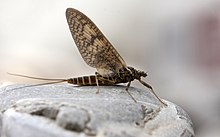Heptageniidae: Difference between revisions
m Task 18 (cosmetic): eval 4 templates: hyphenate params (1×); |
added genus |
||
| (8 intermediate revisions by 6 users not shown) | |||
| Line 1: | Line 1: | ||
{{Short description|Family of mayflies}} |
|||
{{Taxobox |
|||
{{Automatic taxobox |
|||
| ⚫ | |||
| ⚫ | |||
| image = Ephemeroptera 2.jpg |
| image = Ephemeroptera 2.jpg |
||
| image_caption = ''[[Rhithrogena germanica]]'' |
| image_caption = ''[[Rhithrogena germanica]]'' |
||
| display_parents = 2 |
|||
| regnum = [[Animal]]ia |
|||
| ⚫ | |||
| phylum = [[Arthropoda]] |
|||
| authority = Needham, 1901 |
|||
| classis = [[Insecta]] |
|||
| ⚫ | |||
| ordo = [[Ephemeroptera]] |
|||
| |
| subdivision = ''[[Acanthomola]]''<br /> |
||
| ⚫ | |||
| superfamilia = [[Heptagenioidea]] |
|||
| ⚫ | |||
| familia = '''Heptageniidae''' |
|||
| ⚫ | |||
| ⚫ | |||
| ⚫ | |||
| ⚫ | |||
''[[Cinygmula]]''<br /> |
|||
''[[ |
''[[Darthus]]''<br /> |
||
''[[ |
''[[Ecdyonurus]]''<br /> |
||
''[[ |
''[[Electrogena]]''<br /> |
||
''[[ |
''[[Epeorus]]''<br /> |
||
''[[ |
''[[Heptagenia]]''<br /> |
||
''[[ |
''[[Ironodes]]''<br /> |
||
''[[ |
''[[Kageronia]]''<br /> |
||
''[[ |
''[[Leucrocuta]]''<br /> |
||
''[[ |
''[[Maccaffertium]]''<br /> |
||
''[[ |
''[[Macdunnoa]]''<br /> |
||
''[[ |
''[[Nixe (mayfly)|Nixe]]''<br /> |
||
''[[ |
''[[Parafronurus]]''<br /> |
||
''[[ |
''[[Raptoheptagenia]]''<br /> |
||
''[[ |
''[[Rhithrogena]]''<br /> |
||
''[[ |
''[[Stenacron]]''<br /> |
||
| ⚫ | |||
| ⚫ | |||
| ⚫ | |||
| ⚫ | |||
''[[Stenonema]]'' |
''[[Stenonema]]'' |
||
}} |
}} |
||
| ⚫ | The '''Heptageniidae''' (synonym: Ecdyonuridae) are a family of [[mayfly|mayflies]] with over 500 described species mainly distributed in the [[Holarctic]], Oriental, and [[Afrotropical]] regions, and also present in the Central American Tropics and extreme northern South America.<ref>{{cite journal|last=Wang|first=T.-Q|author2=MCCafferty W.P.|title=Heptageniidae (Ephemeroptera) of the World. Part I: Phylogenetic Higher Classification|journal=Transactions of the American Entomological Society|date=March 2004|volume=130|issue=1|pages=11–45|jstor=25078834}}</ref> These are generally rather small mayflies with three long tails. The wings are usually clear with prominent venation although species with variegated wings are known. As in most mayflies, the males have large [[compound eye]]s, but not divided into upper and lower parts |
||
| ⚫ | The '''Heptageniidae''' (synonym: Ecdyonuridae) are a family of [[mayfly|mayflies]] with over 500 described species mainly distributed in the [[Holarctic]], Oriental, and [[Afrotropical]] regions, and also present in the Central American Tropics and extreme northern South America.<ref>{{cite journal|last=Wang|first=T.-Q|author2=MCCafferty W.P.|title=Heptageniidae (Ephemeroptera) of the World. Part I: Phylogenetic Higher Classification|journal=Transactions of the American Entomological Society|date=March 2004|volume=130|issue=1|pages=11–45|jstor=25078834}}</ref> The group is sometimes referred to as '''flat-headed mayflies''' or '''stream mayflies'''. These are generally rather small mayflies with three long tails. The wings are usually clear with prominent venation although species with variegated wings are known. As in most mayflies, the males have large [[compound eye]]s, but not divided into upper and lower parts. |
||
| ⚫ | Heptageniids breed mainly in fast-flowing [[stream]]s |
||
| ⚫ | Heptageniids breed mainly in fast-flowing [[stream]]s, but some species use still waters. The [[nymph (biology)|nymphs]] have a flattened shape and are usually dark in colour. They use a wide range of food sources with [[herbivore|herbivorous]], [[scavenger|scavenging]], and [[predation|predatory]] species known. |
||
| ⚫ | |||
| ⚫ | |||
==References== |
==References== |
||
| Line 45: | Line 43: | ||
*{{cite book|last=McGavin|first=George C.|title=Insects and Spiders|year=2005|publisher=Dorling Kindersley|location=London|isbn=1-4053-0596-7}} |
*{{cite book|last=McGavin|first=George C.|title=Insects and Spiders|year=2005|publisher=Dorling Kindersley|location=London|isbn=1-4053-0596-7}} |
||
*{{cite journal|last=Webb|first=J.M.|author2=McCafferty W.P.|title=Heptageniidae of the World: Part II|journal=Canadian Journal of Arthropod Identification|date=30 October 2008|pages=1–55|doi=10.3752/cjai.2008.07|url=http://www.biology.ualberta.ca/bsc/ejournal/wm_07/wm_07.html|access-date=1 July 2011|doi-access=free}} |
*{{cite journal|last=Webb|first=J.M.|author2=McCafferty W.P.|title=Heptageniidae of the World: Part II|journal=Canadian Journal of Arthropod Identification|date=30 October 2008|pages=1–55|doi=10.3752/cjai.2008.07|url=http://www.biology.ualberta.ca/bsc/ejournal/wm_07/wm_07.html|access-date=1 July 2011|doi-access=free}} |
||
*[http://www.faunaeur.org/full_results.php?id=11225 Fauna Europaea] |
*[https://web.archive.org/web/20051216171754/http://www.faunaeur.org/full_results.php?id=11225 Fauna Europaea] |
||
*[https://web.archive.org/web/20061106031705/http://www.nearctica.com/nomina/oddbugs/epheml.htm#anchor129774 Nomina Insecta Nearctica] |
*[https://web.archive.org/web/20061106031705/http://www.nearctica.com/nomina/oddbugs/epheml.htm#anchor129774 Nomina Insecta Nearctica] |
||
| ⚫ | |||
| ⚫ | |||
{{Ephemeroptera|1}} |
{{Ephemeroptera|1}} |
||
{{Taxonbar|from=Q264822}} |
{{Taxonbar|from=Q264822}} |
||
{{Authority control}} |
|||
[[Category:Mayflies]] |
[[Category:Mayflies]] |
||
Latest revision as of 20:25, 12 December 2023
| Heptageniidae Temporal range:
| |
|---|---|

| |
| Rhithrogena germanica | |
| Scientific classification | |
| Domain: | Eukaryota |
| Kingdom: | Animalia |
| Phylum: | Arthropoda |
| Class: | Insecta |
| Order: | Ephemeroptera |
| Suborder: | Pisciforma |
| Superfamily: | Heptagenioidea |
| Family: | Heptageniidae Needham, 1901 |
| Genera | |
|
Acanthomola | |
The Heptageniidae (synonym: Ecdyonuridae) are a family of mayflies with over 500 described species mainly distributed in the Holarctic, Oriental, and Afrotropical regions, and also present in the Central American Tropics and extreme northern South America.[1] The group is sometimes referred to as flat-headed mayflies or stream mayflies. These are generally rather small mayflies with three long tails. The wings are usually clear with prominent venation although species with variegated wings are known. As in most mayflies, the males have large compound eyes, but not divided into upper and lower parts.
Heptageniids breed mainly in fast-flowing streams, but some species use still waters. The nymphs have a flattened shape and are usually dark in colour. They use a wide range of food sources with herbivorous, scavenging, and predatory species known.
The oldest described member of the family is Amerogenia from the Late Cretaceous (Turonian) aged New Jersey amber.
References[edit]
- Chinery, Michael (1986). Collins Guide to the Insects of Britain and Western Europe. London: Collins. ISBN 0-00-219170-9.
- McGavin, George C. (2005). Insects and Spiders. London: Dorling Kindersley. ISBN 1-4053-0596-7.
- Webb, J.M.; McCafferty W.P. (30 October 2008). "Heptageniidae of the World: Part II". Canadian Journal of Arthropod Identification: 1–55. doi:10.3752/cjai.2008.07. Retrieved 1 July 2011.
- Fauna Europaea
- Nomina Insecta Nearctica
 Data related to Heptageniidae at Wikispecies
Data related to Heptageniidae at Wikispecies
